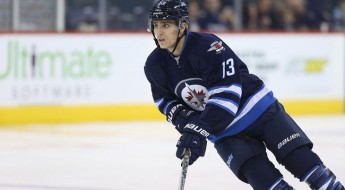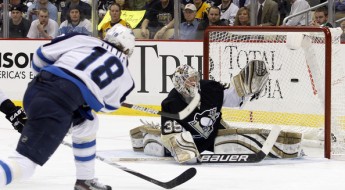The crash and burn of the Colorado Avalanche
In the spring of 2013, it looked like the Colorado Avalance were following a marvelous script. That beautiful, rebuilding script the media loves – the one Pittsburgh and Chicago had showed everyone how to do.
It went something like this:
Summer of 2013, draft Nathan MacKinnon first overall. He scores 26 goals and 62 points as an 18 year old and the team skyrockets to a 112-point season. MacKinnon has joined a promising young core: Matt Duchene is 22, Ryan O’Reilly is 22, Tyson Barrie is 22, and their Captain, Gabe Landeskog, is 21.
Jamie McGinn, Paul Stastny, John Mitchell, and P.A. Parenteau provide solid veteran stability.
Semyon Varlamov, too, was proving a fantastic acquisition, he finished fourth (!) in Hart Trophy voting when they made the playoffs.
With Tyson Barrie being 22 years old and Erik Johnson in the prime of his career, it looked like the Avs were starting a long streak of playoff contention.
Until… They dropped to 90 points in 2014-15, then 82 in 2015-16, and.. Patrick Roy had seen enough.
They hired Jared Bednar, the team was out of the playoffs by December, and the value of just about everyone other than Mikko Rantanen got chopped in half.
What happened?
Home calling
Paul Stastny went to university in Denver but grew up in St. Louis, and ended up having to decide between both of his two “homes”. Return to where he grew up, or stay where his hockey career launched – both as a student athlete and a professional in the NHL?
Ultimately, Stastny chose to head back to St. Louis and join a team that looked ready to explode.
Which was precisely when the Avs took that first step toward their demise.
From last in the league to a 112-point season. How’d they do it?
We’ll start from the net out:
Semyon Varlamov went 41-14-6 with a .927 save percentage, and finished fourth in Hart Trophy voting. The first and second round picks exchanged to acquire him was looking like no problem.
On the blue line, Tyson Barrie emerged as an offensive performer, and complemented Erik Johnson. Both scored over 35 points, and they each could anchor a pairing. Andre Benoit, Nick Holden, and Jan Hejda provided capable depth.
Then the offense. Specifically, up the middle:
___-Stastny-___
___-MacKinnon-___
___-O’Reilly-___
This let Matt Duchene play as winger; a position he plays best at.
With those three at center, it’s pretty easy to see why they jumped to 112 points. When your third center is a second or first line center on many other teams, it gives you superb roster flexibility. Shall we compare a recent example?
___-Matthews-___
___-Kadri-___
___-Bozak-____
Ah yes, that’s why they finally made the playoffs. That beautiful thing called center depth.
So right when Stastny decided to head to Missouri, they took a shot to the gut right where they were strongest. At center ice.
Do 112 point teams recover from losing top line caliber centermen?
Probably not.
The Avs did what they could to offset the loss of their staple since the 2006 post-lockout year, but replacing center depth without centermen is a tough task. Jarome Iginla was a smart addition (what if they kept Stastny and added Iggy?), but a coach’s line matching life is very simple with three quality centermen, and they now only had two.
Now Colorado’s offense looked like this (again keeping Duchene on the wing):
___-MacKinnon-___
___-O’Reilly-___
___-Mitchell-___
Not a bad top-two, but as a trio it’s way worse.
Then, they put their second foot toward becoming a 48-point team.
Yucky contract situation
Ryan O’Reilly surprisingly made the team as an 18 year old 2nd round draft pick, and did not diasppoint. In fact, the 2009 NHL draft was looking to be one of the best in recent history for the Avs, snagging Duchene at 3rd, O’Reilly at 33rd, and Tyson Barrie at 64th. Saucy.
After 2 solid introductory seasons in the league, O’Reilly found his offense, putting up 55 points as a 21 year old center. And he was a seasoned one; it looked like the Avs had a two-way centerman for the next decade.
That’s about it as good as it got for the Avalanche. O’Reilly would hold out at the end of every contract, demanding to paid as the player he believed he was. Eventually, he signed an offer sheet by the Flames, which the Avs of course would match.
Finally, at 24 years of age, O’Reilly wanted the payday he worked for his entire life. But, as far as I can tell, Avalanche brass was either unwilling to pay up, or O’Reilly’s heart was never in Colorado to begin with.
Then he was shipped to Buffalo where he consequently signed a 7-year, $52.5 million contract.
Ultimately, $7.5-million per year isn’t cheap for what he does, but wouldn’t that be better than what the Avs are up to now? Mikael Grigorenko, and Nikita Zadorov seemed an okay return at the time, but Grigorenko is now in the KHL. Zadorov may become a top-4 NHL defenseman – but still – top caliber two-way centermen are hard to replace.
For the second consecutive season their center ice took a hit. The middle of their lineup now looked like this:
___-MacKinnon-___
___-Soderberg-___
___-Mitchell-____
Whoops.
That’s just not championship caliber. Heck, that’s not even playoff caliber. You could put Duchene in there and it looks better, but I think Colorado is at their best when he’s on the wing. After all, that’s when they got 112 points.
In the end, general manager Joe Sakic did nothing to address the center ice dilemmas clearly facing the team, and Patrick Roy walked out. Could ya blame him? He was the one who brought them to the playoffs. Then he lost a top tier center. And another one. After that, he was no longer interested in the direction of the team.
You’re a tough personality, Mister Roy.
But you probably had a reasonable point on that one.
**
Can Jost, Rantanen, and MacKinnon be the group that lifts Colorado from the basement?



